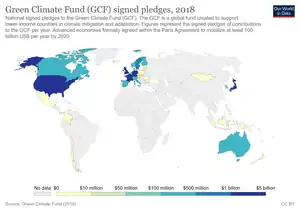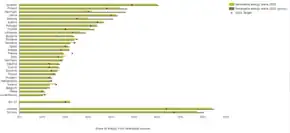Climate target
A climate target, climate goal or climate pledge is a measurable long-term commitment for climate policy and energy policy with the aim of limiting the climate change. Researchers within, among others, the UN climate panel have identified probable consequences of global warming for people and nature at different levels of warming. Based on this, politicians in a large number of countries have agreed on temperature targets for warming, which is the basis for scientifically calculated carbon budgets and ways to achieve these targets. This in turn forms the basis for politically decided global and national emission targets for greenhouse gases, targets for fossil-free energy production and efficient energy use, and for the extent of planned measures for climate change mitigation and adaptation. Many climate targets are implemented in national climate legislation.




Calculation of Emissions Targets
An emissions target or greenhouse gas emissions reduction target is a central policy instrument of international greenhouse gas emissions reduction politics and a key pillar of climate policy.[2][3][4][5][6][7] They typically include heavy consideration of emissions budgets, which are calculated using rate of warming per standard emission of carbon dioxide, a historic baseline temperature, a desired level of confidence and a target global average temperature to stay below.[8]
An "emissions target" may be distinguished from an emissions budget, as an emissions target may be internationally or nationally set in accordance with objectives other than a specific global temperature. This includes targets created for their political palatability, rather than budgets scientifically determined to meet a specific temperature target.[9][10]
A country's determination of emissions targets is based on careful consideration of pledged NDCs (nationally determined contributions), economic and social feasibility, and political palatability.[11] Carbon budgets can provide political entities with knowledge of how much carbon can be emitted before likely reaching a certain temperature threshold, but specific emissions targets take more into account. The exact way these targets are determined varies widely from country to country. Variation in emissions targets and time to complete them depends on factors such as accounting of land-use emissions, afforestation capacity of a country, and a countries transport emissions.[12] Importantly, emissions targets also depend on their hypothesized reception.
Many emissions pathways, budgets and targets also rely on the implementation of negative emissions technology.[13] These currently undeveloped technologies are predicted to pull net emissions down even as source emissions are not reduced.
Effectiveness of Targets
Many countries' emissions targets are above the scientifically calculated allowable emissions to remain below a certain temperature threshold.[14][15] In 2015, many countries pledged NDCs to limit the increase in the global average temperature to well below 2 °C above pre-industrial levels.[16] Many of the largest emitters of GHGs, however, are on track to push global average temperature to as much as 4 °C.[14] Some of these projections contradict agreements made in the 2015 Paris Agreement, meaning countries are not keeping to their pledged NDCs.
In addition, it is uncertain how effective many emissions targets and accompanying policies really are.[17] For example, with countries that have high consumption-based carbon emissions, strictly enforced, aligned and coordinated international policy measures determine the effectiveness of targets. In addition, many ambitious policies are proposed and passed but are not practically enforced or regulated, or have unintended consequences. China's ETS (emissions trading scheme), while seeming to have an effect on reducing production-based emissions also promoted outsourcing of emissions contributing to a further imbalance of carbon transfer among China's different provinces.[18] The ETS evaluation also did not account for exported consumption-based emissions.
Many countries aim to reach net zero emissions in the next few decades.[12] In order to reach this goal however, there must be a radical shift in energy infrastructure.[19] For example, in the United States, political entities are attempting to switch away from coal and oil based energy by replacing plants with natural gas combined cycle (NGCC) power plants. [20] Other countries like the Netherlands were obligated by the District Court of Hague to reduce its greenhouse gas emissions by 25% by 2020. The Court has passed other innovations (Milieudefensie v. Royal Dutch Shell) to reduce dioxide emissions by 45% by 2030.[21]However many find this transition to not be significant enough to reach net-zero emissions.[20][22] More significant changes, for example using biomass energy with carbon capture and storage (BECCS) are suggested as a viable option to transition to net-zero emissions countries.[23][24]
See also
References
- Christiana Figueres u. a. (2017), "Three years to safeguard our climate", Nature (in German), vol. 546, no. 7660, pp. 593–595, Bibcode:2017Natur.546..593F, doi:10.1038/546593a, PMID 28661507
- Meinshausen, Malte; Meinshausen, Nicolai; Hare, William; Raper, Sarah C. B.; Frieler, Katja; Knutti, Reto; Frame, David J.; Allen, Myles R. (30 April 2009). "Greenhouse-gas emission targets for limiting global warming to 2 °C". Nature. 458 (7242): 1158–1162. Bibcode:2009Natur.458.1158M. CiteSeerX 10.1.1.337.3632. doi:10.1038/nature08017. ISSN 1476-4687. PMID 19407799. S2CID 4342402.
- Matthews, H. Damon; Zickfeld, Kirsten; Knutti, Reto; Allen, Myles R. (2018). "Focus on cumulative emissions, global carbon budgets and the implications for climate mitigation targets". Environmental Research Letters. 13 (1): 010201. Bibcode:2018ERL....13a0201D. doi:10.1088/1748-9326/aa98c9. ISSN 1748-9326.
- Raupach, Michael R.; Davis, Steven J.; Peters, Glen P.; Andrew, Robbie M.; Canadell, Josep G.; Ciais, Philippe; Friedlingstein, Pierre; Jotzo, Frank; Vuuren, Detlef P. van (21 September 2014). "Sharing a quota on cumulative carbon emissions". Nature Climate Change. 4 (10): 873–879. Bibcode:2014NatCC...4..873R. doi:10.1038/nclimate2384. ISSN 1758-6798.
- Friedlingstein, P., Andrew, R. M., Rogelj, J., Peters, G. P., Canadell, J. G., Knutti, R., ... & Le Quéré, C. (2014). Persistent growth of CO2 emissions and implications for reaching climate targets. Nature geoscience, 7(10), 709.
- Jackson, Tim. "2050 is too late – we must drastically cut emissions much sooner". The Conversation. Retrieved 2019-09-23.
- Zickfeld, K.; Arora, V. K.; Gillett, N. P. (2012-03-01). "Is the climate response to CO2 emissions path dependent?". Geophysical Research Letters. 39 (5): L05703. Bibcode:2012GeoRL..39.5703Z. doi:10.1029/2011gl050205. ISSN 1944-8007.
- Rogelj, Joeri; Forster, Piers M.; Kriegler, Elmar; Smith, Christopher J.; Séférian, Roland (17 July 2019). "Estimating and tracking the remaining carbon budget for stringent climate targets". Nature. 571 (7765): 335–342. Bibcode:2019Natur.571..335R. doi:10.1038/s41586-019-1368-z. PMID 31316194.
- Babiker, Mustafa H.; Eckaus, Richard S. (2002-09-01). "Rethinking the Kyoto Emissions Targets". Climatic Change. 54 (4): 399–414. doi:10.1023/A:1016139500611. ISSN 0165-0009. S2CID 154819244.
- Zickfeld, Kirsten; Eby, Michael; Matthews, H. Damon; Weaver, Andrew J. (2009-09-22). "Setting cumulative emissions targets to reduce the risk of dangerous climate change". Proceedings of the National Academy of Sciences. 106 (38): 16129–16134. doi:10.1073/pnas.0805800106. ISSN 0027-8424. PMC 2752604. PMID 19706489.
- Babiker, Mustafa H.; Eckaus, Richard S. (2002). "Rethinking the Kyoto Emissions Targets". Climatic Change. 54 (4): 399–414. doi:10.1023/A:1016139500611. S2CID 154819244.
- van Soest, Heleen L.; den Elzen, Michel G. J.; van Vuuren, Detlef P. (2021-04-09). "Net-zero emission targets for major emitting countries consistent with the Paris Agreement". Nature Communications. 12 (1): 2140. Bibcode:2021NatCo..12.2140V. doi:10.1038/s41467-021-22294-x. ISSN 2041-1723. PMC 8035189. PMID 33837206.
- Johansson, Daniel J A; Azar, Christian; Lehtveer, Mariliis; Peters, Glen P (2020-12-05). "The role of negative carbon emissions in reaching the Paris climate targets: The impact of target formulation in integrated assessment models". Environmental Research Letters. 15 (12): 124024. Bibcode:2020ERL....15l4024J. doi:10.1088/1748-9326/abc3f0. ISSN 1748-9326.
- Korppoo, Anna; Kokorin, Alexey (2017-02-17). "Russia's 2020 GHG emissions target: Emission trends and implementation". Climate Policy. 17 (2): 113–130. doi:10.1080/14693062.2015.1075373. hdl:11250/2485906. ISSN 1469-3062. S2CID 154257631.
- "Home | Climate Action Tracker". climateactiontracker.org. Retrieved 2021-04-28.
- "Paris Agreement, FCCC/CP/2015/L.9/Rev.1" (PDF). UNFCCC secretariat. 12 December 2015. Retrieved 28 April 2021.
- Nabernegg, Stefan; Bednar-Friedl, Birgit; Muñoz, Pablo; Titz, Michaela; Vogel, Johanna (April 2019). "National Policies for Global Emission Reductions: Effectiveness of Carbon Emission Reductions in International Supply Chains". Ecological Economics. 158: 146–157. doi:10.1016/j.ecolecon.2018.12.006.
- Gao, Yuning; Li, Meng; Xue, Jinjun; Liu, Yu (August 2020). "Evaluation of effectiveness of China's carbon emissions trading scheme in carbon mitigation". Energy Economics. 90: 104872. doi:10.1016/j.eneco.2020.104872. S2CID 225437125.
- Pye, S.; Broad, O.; Bataille, C.; Brockway, P.; Daly, H. E.; Freeman, R.; Gambhir, A.; Geden, O.; Rogan, F.; Sanghvi, S.; Tomei, J. (2021-02-07). "Modelling net-zero emissions energy systems requires a change in approach". Climate Policy. 21 (2): 222–231. doi:10.1080/14693062.2020.1824891. ISSN 1469-3062.
- Sproul, Evan; Barlow, Jay; Quinn, Jason C. (2020-12-01). "Time-Resolved Cost Analysis of Natural Gas Power Plant Conversion to Bioenergy with Carbon Capture and Storage to Support Net-Zero Emissions". Environmental Science & Technology. 54 (23): 15338–15346. Bibcode:2020EnST...5415338S. doi:10.1021/acs.est.0c04041. ISSN 0013-936X. PMID 33183006. S2CID 226850670.
- Benoit, Mayer (July 2022). "The Duty of Care of Fossil-Fuel Producers for Climate Change Mitigation: Milieudefensie v. Royal Dutch Shell District Court of The Hague (The Netherlands)". ProQuest. 11. doi:10.1017/S2047102522000103. ProQuest 2688520401.
- Zhang, Xiaochun; Myhrvold, Nathan P.; Hausfather, Zeke; Caldeira, Ken (April 2016). "Climate benefits of natural gas as a bridge fuel and potential delay of near-zero energy systems". Applied Energy. 167: 317–322. doi:10.1016/j.apenergy.2015.10.016.
- Wang, Rui; Chang, Shiyan; Cui, Xueqin; Li, Jin; Ma, Linwei; Kumar, Amit; Nie, Yaoyu; Cai, Wenjia (January 2021). "Retrofitting coal‐fired power plants with biomass co‐firing and carbon capture and storage for net zero carbon emission: A plant‐by‐plant assessment framework". GCB Bioenergy. 13 (1): 143–160. doi:10.1111/gcbb.12756. ISSN 1757-1693.
- Tokimatsu, Koji; Yasuoka, Rieko; Nishio, Masahiro (January 2017). "Global zero emissions scenarios: The role of biomass energy with carbon capture and storage by forested land use". Applied Energy. 185: 1899–1906. doi:10.1016/j.apenergy.2015.11.077.
